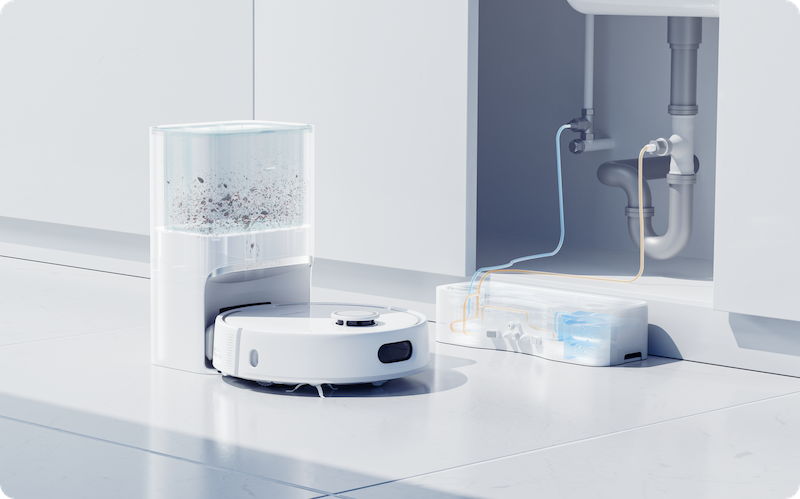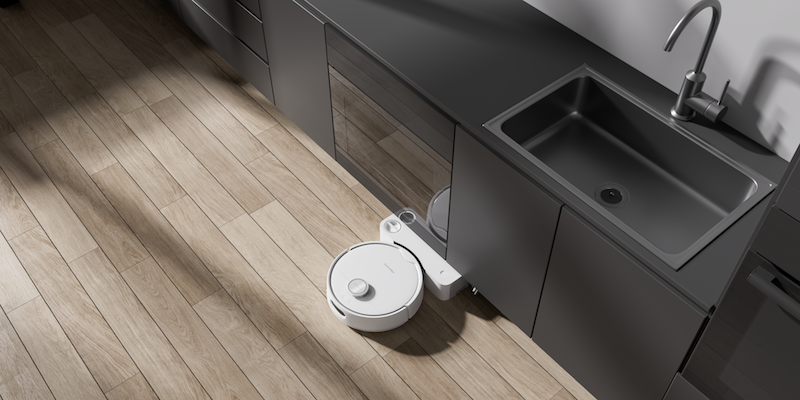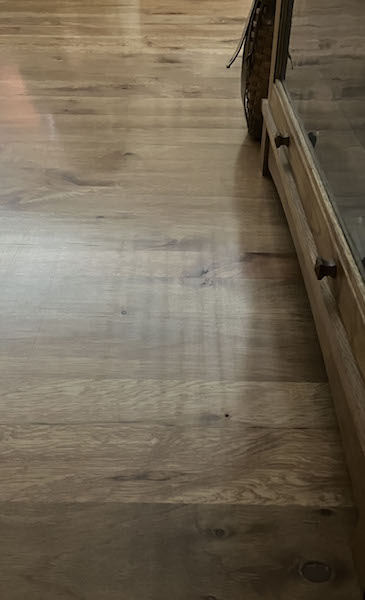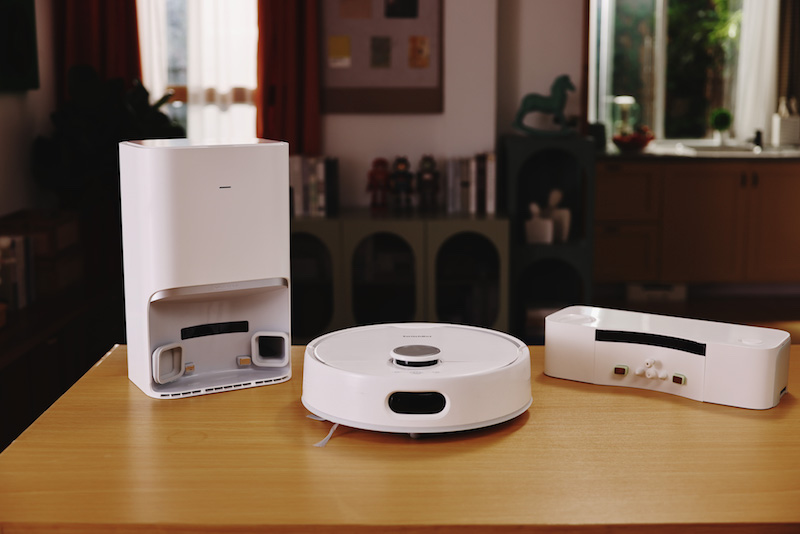For most people, cleaning a home is the pinnacle of drudgery. I’m not talking about picking items up around the house to keep things neat and tidy. I’m talking about dusting, scrubbing the bathroom, washing windows (see the earlier article I wrote on this here), and, of course, vacuuming and mopping floors.
Today, there are a wide range of robotic vacuum/mops on the market that can eliminate the chore of cleaning the floors in your home. However, there are key features that I believe today’s floor cleaning robots need to include:
- The ability to work autonomously whether the homeowners are home, or not.
- Floor cleaning robots need to work efficiently and clean in a minimum amount of time because they are noisy and annoying.
- Floor cleaning robots need to do their work in an organized, predictable, and efficient way.
- Floor cleaning robots need to be gentle on your furnishings.
- Floor cleaning robots need to support spot cleaning or, at a minimum, just cleaning a specific room instead of the entire floor plan.
- Floor cleaning robots need to avoid obstacles so they don’t get stuck on extension cords or spread a mess, left by a pet, around the home.
- Floor cleaning robots should include the ability for them to be integrated into the ecosystem of a smart home. An integrated floor cleaning robot can automatically be sent on its cleaning mission when the home becomes unoccupied; minimizing the noise and inconvenience for the homeowners and their family.
Over the years I have owned far too many robotic vacuums and mops, trying to find products that meet as many of the above criteria as possible. Not long ago, I wrote a review of the Narwal Freo X Plus robotic vacuum/mop (that article can be found here). The Freo X Plus is Narwal’s base model. In contrast, SwitchBot provided me with a sample of their new SwitchBot Floor Cleaning Robot S10 to evaluate for this article, which is their most advanced floor cleaning robot.

The most innovative aspect of the S10 is how autonomous it is. These days, many robotic vacuums include technology to automatically empty the vacuum of dust and debris at the charging station. The SwitchBot S10 goes a step further and incorporates a second base station that can be connected to the home’s plumbing, empties dirty water from the built-in mop, and refills it with clean water.
The water station is operated by an internal battery. However, there is no need for the homeowner to charge it as it will be charged automatically by the S10 cleaning robot when needed. Finally, the 4-liter, dust bag in the charging station can hold approximately 70 days of dust and debris, making this an almost completely hands-off floor cleaning solution.
SwitchBot also added several innovative improvements to how the S10 mops compared to competitive products. First, the S10’s mop roller automatically retracts when the S10 encounters carpeting or rugs, so it won’t get them wet. In addition, when the mop confronts a carpet, a scraper will remove the remaining moisture from the surface of the roller mop to ensure that even if the mop surface comes into contact with the carpet, it won’t wet the carpet.
Second, the S10 cleans the mop roller during operation. So, if the S10 traverses, for example, spilled ketchup on the floor, unlike other robotic mops, it won’t spread the ketchup around the room.
Finally, the docking station automatically dries the mop when the S10 has finished cleaning. Anyone with a robotic mop, myself included, has forgotten to change the pad after the mop has run. A day or two later, mold and mildew has started to grow on the wet pad, creating an unpleasant odor in the home. Since the S10 cleans and dries the roller mop pad, this situation is entirely avoided and there is simply no need to change the mop pad after each mopping run.
Some of the other features of the SwitchBot S10 are a rubber vacuum brush that is designed to minimize hair tangles, voice control, 6500pa of suction power, and LiDAR navigation.
The use of AI to help the S10 avoid obstacles. The SwitchBot S10 does use a camera. However, according to SwitchBot, images from the camera are never uploaded to the cloud. They are processed for obstacle avoidance in the cleaning robot. This is in sharp contrast to some manufacturers that use cameras for navigation in the cleaning robots and collect images of user’s homes.
Integration
SwitchBot offers integration of the S10 with a number of smart home platforms, including Alexa, Google Assistant, Siri Shortcuts, IFTTT, SmartThings, and the Matter protocol. As a Matter Bridge, the S10 cleaning robot simply appears in the Apple Home app as a smart switch that can be turned on to start the cleaning robot. No additional functionality is supported through Matter at this time. SwitchBot REST API can be used to develop drivers to integrate SwitchBot products, including the S10, with other smart home platforms. I have leveraged this API to add support for the S10 to the Crestron-SwitchBot driver that I’ve written. The driver is a free download from my GitHub.
In the Box
The SwitchBot S10 includes everything you will need to get it installed, working, and maintain it over time. The system that I was provided with included:
- The S10 vacuum/mop
- Charging/dust station that automatically empties the S10 vacuum and dries the roller mop
- Water station that automatically drains dirty water from the S10 and refills it with clean water.
- Tools for cleaning the S10 and the charging/dust station
- Replacement side brush
- Charging/dust station bags
- Mop cleaning solution
- Plumbing fittings for a variety of Installation options and a wrench to assist with the Installation
- Clean and Dirty water tank add-on that can be used as an alternative for connecting the water station to your home’s plumbing
- SwitchBot Water Leak Detector
- User manual and quick-start guide
Setup
Because the S10 has two base stations, one of which you will probably want to connect to your home’s plumbing, you need to think through your installation. In addition, the height of the auto-emptying charging station means that it can’t be hidden beneath a piece of furniture. Some other manufacturers of robotic vacuum/mops with water changing abilities use a single, large base station. Whether two smaller base stations work better for you than a single larger station is going to depend on your specific circumstances and the layout of your home.

SwitchBot provides multiple options for connecting the S10’s water station to your plumbing, so it has a continuous supply of fresh water and can empty the dirty water it collects from the S10. SwitchBot includes connectors for hooking up the water station to a typical sink/drain that you would find in a bathroom, hooking the water station up to a toilet, hooking the water station up to a kitchen sink with a garbage disposal installed, and more. The documentation and the video tutorial walk you through all the options.
While connecting the water station isn’t complicated, those that don’t feel comfortable with the process can use the included clean and dirty water tanks instead. These allow the robot to work autonomously for up to a week, assuming daily usage. For my evaluation, I decided not to connect the water station with my plumbing and just use the clean and dirty water tanks.
If you do connect the water station to your home’s plumbing, I would highly recommend that you make use of a water leak sensor. Even a slow water leak can cause thousands of dollars of damage to a home, including the need for mold remediation. Taking a few minutes to install a leak detector where you have connected the S10 Water Station to your plumbing could save you a tremendous amount of trouble.
SwitchBot included their new SwitchBot Water Leak Detector with my S10. It can sense water drips, water immersion, and high-water levels. It includes four sensors and they can detect water levels as low as 0.5mm. SwitchBot is also working on making their Water Leak Detector compatible with the Matter protocol using a SwitchBot hub as a bridge. This will allow the Water Leak Detector to trigger a wide range of smart home platforms in the event of a leak.
Overall, the installation of the S10 was very easy. After unpacking the S10, charging station, and water station, I set them up as described in the Quick Start Guide and the External Water Tank User’s Guide. Next, I simply added the S10 to the SwitchBot app, connected it to my Wi-Fi network, and updated the firmware on the cleaning robot, water station, and charging station.
Next, the app instructed me to perform a quick mapping of my home. This only took a few minutes. The process was very interesting in that I could watch as the S10’s lidar discovered the extent of my home and the map was created in real time on the screen of my iPad. Finally, I had to manually position where the water station was located on the map. I misread the landmarks on the map and was a few feet off on my positioning of the water station. After a few tries to find it, the robot asked me to manually dock it to the water station. Once I had manually docked the cleaning robot, it knew where the water station was located.
Editing the map that was created was also very easy. The map was already divided into rooms, and the app allowed you to edit the names of rooms, combine adjacent areas into a single room if that better represents how you view your home, split a room into two rooms if that better represents how you view your home, add/edit No-Go Zones, and add/edit Virtual Walls.
With my map setup to match my home and to keep the robot from trying to vacuum a rug with a fringed border where the fringes would be tangled by the robot’s side brush and trap it, I was ready to start cleaning.
Cleaning
The first thing you will notice about the S10 is its size. It is a large robotic vacuum measuring a little more than 14” in diameter and 4.5” high. This is larger than many other competing products and does, in some cases, limit the places that the S10 can clean. In my home, the S10 wasn’t able to clean under a few pieces of our furniture because the robot is too tall to fit under them.
The SwitchBot S10 navigates very efficiently during cleaning. It cleans each room, individually and in turn, first traversing the border of the room and then moving back and forth in rows to clean the remainder of the space.
With its lidar- and AI-driven camera, I hoped that the S10 would be better at navigating close to, but not touching, furnishings during cleaning. It gently bumps into furnishings quite a bit when traversing the borders of a room. Having some antique furniture in our home, I am quite sensitive to the potential for repetitive bumping by a floor cleaning robot, over time, causing damage. Fortunately, when the S10 did bump into a piece of furniture it seemed to be a reasonably gentle bump. These bumps were significantly gentler than those from some earlier robotic floor cleaning robots I’ve had that navigated using cameras.
When cleaning was complete, the S10 went back to the water station, emptied the dirty water it had collected, refilled with clean water, and proceeded to the charging station where it emptied dust from the vacuum, started charging, and started blowing warm air on the mop to dry it. I didn’t precisely time how long it took to dry the mop pad, but the process continued for several hours.
I did run into a couple of problems with the S10’s cleaning. First, I tested the AI-driven obstacle avoidance. This didn’t work very well for me. Initially, I left an approximately 8” tall stuffed toy on the ground to simulate something a child might have dropped. The S10 did, for the most part, avoid it. However, the S10 did push the toy around a bit instead of completely avoiding it.
Next, I placed some fake, plastic, dog poop on the floor that I purchased specifically for testing floor cleaning robots. The S10 didn’t avoid the fake poop at all and tried to drive right over it. Had this been real poop it could have been spread around the house by the S10. I have read where the S10 didn’t have a problem avoiding fake dog poop for some other testers. It could have been that I was placing fake, brown, dog poop on brown hardwood floor that caused the S10 not to recognize it.
Finally, I left a bunched-up extension cord on the ground. Extension cords are notorious for getting tangled in the brushes of a robotic vacuum. Like the stuffed animal, the robot mostly avoided the extension cord but did push it around a bit. The extension cord didn’t get tangled in the robot’s brushes.
According to SwitchBot, “the S10 will continuously upgrade its AI avoidance function by constantly studying the data that it generated from its surroundings. So, it will become more and more advanced in terms of AI avoidance.”

Another problem I had with the mop was streaking. As you can see in the photo above, the robot left streaks on my wood floors. I’m not sure why this occurred since the area behind the robot, when it was mopping, was evenly wet. However, I have noticed that after multiple cleaning missions the streaking is becoming less evident. So, this may be due to the way the mop is manufactured and the issue will completely vanish over time.
One day my wife needed to use the outlet where the S10’s charging station was plugged in. When she unplugged the charging station, which simulated a power outage, the S10 suddenly started on a cleaning mission. I’ve reported this problem to SwitchBot so it should be addressed in a future software update. However, until that happens, if you live in an area prone to power outages, the S10 could wake you up in the middle of the night if one occurs.
Summary
The features of the S10 check off almost all the requirements I listed in the beginning of the article for a robotic cleaning system.
- It can work autonomously whether the homeowners are home, or not. A homeowner can create no-go zones, no-mop zones, and virtual walls to keep the S10 out of areas where it could get into trouble
- It cleans efficiently and quickly
- It cleans in an orderly, not a random, pattern to minimize disruptions to family members that are working in the home
- It avoids contact with furniture and other objects in a room
- The S10 can be sent on a mission to clean the whole home or just an individual room where the floor is dirty
- SwitchBot offers multiple options for integrating the S10 into a smart home’s ecosystem
If you choose to connect the water station to your home’s plumbing, the S10 becomes almost completely hands free as you only have to empty the dust bag in the charging station every 70 days. If you choose to use the clean and dirty water canisters instead of connecting the water station to your plumbing, then those will require filling/emptying approximately once per week for an average sized home based on daily use.
However, I did see some issues with the AI driven obstacle avoidance and the mop leaving streaks on our hardwood floors. The AI obstacle avoidance, as SwitchBot says, should improve over time. I also expect that future firmware updates will also address this. The streaking also appears to be slowly getting better with ongoing use of the system.






![ecobee premium airzone control The ecobee Smart Thermostat Premium. [Photo credit | ecobee]](https://restechtoday.com/wp-content/uploads/2025/06/ecobee-premium.jpg)
![Hub 3_02 The SwitchBot Hub 3 provides a user-friendly solution to the growing complexity of modern smart homes. [Photo credit | SwitchBot]](https://restechtoday.com/wp-content/uploads/2025/06/Hub-3_02-scaled-e1750179791687.png)
